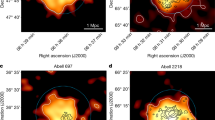Abstract
We have reinvestigated the reported tendency for the extended radio structures associated with bright elliptical galaxies to be oriented preferentially along the optical minor axes. It is found that such a tendency exists only for those galaxies in which the compact radio cores coincident with their nuclei are quite prominent. If the galaxies are divided into two groups according to whether their cores account for less than or greater than 10 per cent of the total flux density at 2.7 GHz, the angle Φ (between the radio axis and the optical minor axis) appears to be uniformly distributed between 0‡ and 90‡ for the former, but is nearly always < 30‡ for the latter group. One possible explanation is that the radio emission from compact cores suffers thermal absorption by ionized gas that is distributed differently in the two groups.
Similar content being viewed by others
References
Binney, J. J. 1978,Comm. Astrophys.,8, 27.
Blandford, R. D., Konigl, A. 1919,Astrophys. J.,232, 34.
Blandford, R. D., Rees, M. J. 1974,Mon. Not. R. astr. Soc.,169, 395.
Bridle, A. H., Davis, M. M., Fomalont, E. B., Willis, A. G., Strom, R. G. 1979,Astrophys. J.,228, L9.
Bridle, A. H., Fomalont, E. B. 1978,Astr. J.,83, 704.
Burbidge, G., Crowne, A. H. 1979,Astrophys. J. Suppl. Ser.,40, 583.
Burns, J. O., Owen, F. N. 1979,Astr. J.,84, 1478.
Christiansen, W. N., Frater, R. H., Watkinson, A., O’Sullivan, J. D., Lockhart, I. A., Goss, W. M. 1977,Mon. Not. R. astr. Soc.,181, 183.
Condon, J. J., Dressel, L. L. 1978,Astrophys. J.,221, 456.
Ekers, R. D. 1969,Austr. J. Phys., Astrophys. Suppl., No. 6.
Ekers, R. D., Fanti, R., Lad, C., Parma, P. 1981,Astr. Astrophys.,101, 194.
Fanti, C., Fanti, R., Gioia, I. M., Lad, C., Parma, P., Ulrich, M. H. 1977,Astr. Astrophys. Suppl. Ser.,29, 279.
Fanti, R., Gioia, I., Lad, C., Ulrich, M. H. 1978,Astr. Astrophys. Suppl. Ser.,34, 341.
Fomalont, E. B., Bridle, A. H. 1978,Astr. J.,83, 725.
Fomalont, E. B., Palimaka, J. J., Bridle, A. H. 1980,Astr. J.,85, 981.
Goss, W. M., Wellington, K. J., Christiansen, W. N., Lockhart, I. A., Watkinson, A., Frater, R.H., Little, A. G. 1977,Mon. Not. R. astr. Soc.,178, 525.
Guthrie, B. N. G. 1979,Mon. Not. R. astr. Soc.,187, 581.
Guthrie, B. N. G. 1980,Astrophys. Sp. Sci.,70, 211.
Jenkins, C. J., Pooley, G. G., Riley, J. M. 1977,Mem. R. astr. Soc.,84, 61.
Jenkins, C. R. 1981,Mon. Wot. R. astr. Soc.,196, 987.
Jenkins, C. R., Scheuer, P. A. G. 1980,Mon. Not. R. astr. Soc.,192, 595.
Kotanyi, C. G. 1979,Astr. strophys.,74, 156.
Macdonald, G. H., Kenderdine, S., Neville, A. C. 1968,Mon. Not. R. astr. Soc.,138, 259.
Owen, F. N., Rudnick, L., Peterson, B. M. 1977,Astr. J.,82, 677.
Palimaka, J. J., Bridle, A. H., Fomalont, E. B., Brandie, G. W. 1979,Astrophys. J.,231, L7 (PBFB).
Riley, J. M. 1915,Mon. Not. R. astr. Soc.,170, 53.
Riley, J. M., Branson, N. J. B. A. 1973,Mon. Not. R. astr. Soc.,164, 271.
Riley, J. M., Pooley, G. G. 1975,Mem. R. astr. Soc.,80, 105.
Rudnick, L., Adams, M. T. 1979,Astr. J.,84, 437.
Scheuer, P. A. G., Readhead, A. C. S. 1979,Nature,277, 182.
Schilizzi, R. T. 1976,Astr. J.,81, 946.
Schilizzi, R. T., McAdam, W. B. 1975,Mem. R. astr. Soc.,79, 1.
Simkin, S. M. 1979,Astrophys. J.,234, 56.
Strom, R. G., Baker, J. R., Willis, A. G. 1981,Astr. Astrophys.,100, 220.
Van Breugel,W. J. M., Schilizzi, R. T., Hummel, E., Kapahi, V. K. 1981,Astr. Astrophys.,96, 310.
Waggett, P. C., Warner, P. J., Baldwin, J. E. 1977,Mon. Not. R. astr. Soc.,181, 465.
Wilkerson, M. S., Romanishin, W. 1981,Astrophys. J.,243, 427.
Willis, A. G., Strom, R. G., Wilson, A. S. 1974,Nature,250, 625.
Author information
Authors and Affiliations
Rights and permissions
About this article
Cite this article
Kapahi, V.K., Saikia, D.J. Compact radio cores and the relation between the radio and optical axes of elliptical galaxies. J Astrophys Astron 3, 161–171 (1982). https://doi.org/10.1007/BF02714800
Received:
Accepted:
Issue Date:
DOI: https://doi.org/10.1007/BF02714800




